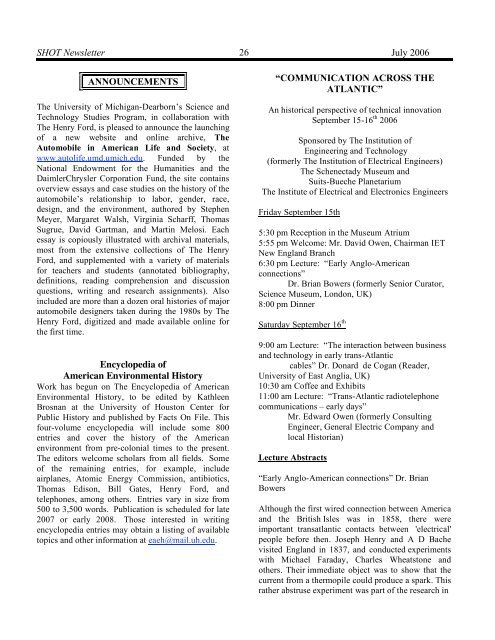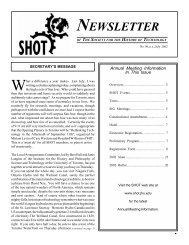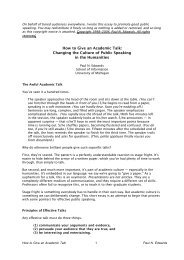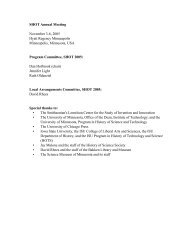In This Issue - Society for the History of Technology
In This Issue - Society for the History of Technology
In This Issue - Society for the History of Technology
Create successful ePaper yourself
Turn your PDF publications into a flip-book with our unique Google optimized e-Paper software.
SHOT Newsletter 26<br />
July 2006<br />
ANNOUNCEMENTS<br />
The University <strong>of</strong> Michigan-Dearborn’s Science and<br />
<strong>Technology</strong> Studies Program, in collaboration with<br />
The Henry Ford, is pleased to announce <strong>the</strong> launching<br />
<strong>of</strong> a new website and online archive, The<br />
Automobile in American Life and <strong>Society</strong>, at<br />
www.autolife.umd.umich.edu. Funded by <strong>the</strong><br />
National Endowment <strong>for</strong> <strong>the</strong> Humanities and <strong>the</strong><br />
DaimlerChrysler Corporation Fund, <strong>the</strong> site contains<br />
overview essays and case studies on <strong>the</strong> history <strong>of</strong> <strong>the</strong><br />
automobile’s relationship to labor, gender, race,<br />
design, and <strong>the</strong> environment, authored by Stephen<br />
Meyer, Margaret Walsh, Virginia Scharff, Thomas<br />
Sugrue, David Gartman, and Martin Melosi. Each<br />
essay is copiously illustrated with archival materials,<br />
most from <strong>the</strong> extensive collections <strong>of</strong> The Henry<br />
Ford, and supplemented with a variety <strong>of</strong> materials<br />
<strong>for</strong> teachers and students (annotated bibliography,<br />
definitions, reading comprehension and discussion<br />
questions, writing and research assignments). Also<br />
included are more than a dozen oral histories <strong>of</strong> major<br />
automobile designers taken during <strong>the</strong> 1980s by The<br />
Henry Ford, digitized and made available online <strong>for</strong><br />
<strong>the</strong> first time.<br />
Encyclopedia <strong>of</strong><br />
American Environmental <strong>History</strong><br />
Work has begun on The Encyclopedia <strong>of</strong> American<br />
Environmental <strong>History</strong>, to be edited by Kathleen<br />
Brosnan at <strong>the</strong> University <strong>of</strong> Houston Center <strong>for</strong><br />
Public <strong>History</strong> and published by Facts On File. <strong>This</strong><br />
four-volume encyclopedia will include some 800<br />
entries and cover <strong>the</strong> history <strong>of</strong> <strong>the</strong> American<br />
environment from pre-colonial times to <strong>the</strong> present.<br />
The editors welcome scholars from all fields. Some<br />
<strong>of</strong> <strong>the</strong> remaining entries, <strong>for</strong> example, include<br />
airplanes, Atomic Energy Commission, antibiotics,<br />
Thomas Edison, Bill Gates, Henry Ford, and<br />
telephones, among o<strong>the</strong>rs. Entries vary in size from<br />
500 to 3,500 words. Publication is scheduled <strong>for</strong> late<br />
2007 or early 2008. Those interested in writing<br />
encyclopedia entries may obtain a listing <strong>of</strong> available<br />
topics and o<strong>the</strong>r in<strong>for</strong>mation at eaeh@mail.uh.edu.<br />
“COMMUNICATION ACROSS THE<br />
ATLANTIC”<br />
An historical perspective <strong>of</strong> technical innovation<br />
September 15-16 th 2006<br />
Sponsored by The <strong>In</strong>stitution <strong>of</strong><br />
Engineering and <strong>Technology</strong><br />
(<strong>for</strong>merly The <strong>In</strong>stitution <strong>of</strong> Electrical Engineers)<br />
The Schenectady Museum and<br />
Suits-Bueche Planetarium<br />
The <strong>In</strong>stitute <strong>of</strong> Electrical and Electronics Engineers<br />
Friday September 15th<br />
5:30 pm Reception in <strong>the</strong> Museum Atrium<br />
5:55 pm Welcome: Mr. David Owen, Chairman IET<br />
New England Branch<br />
6:30 pm Lecture: “Early Anglo-American<br />
connections”<br />
Dr. Brian Bowers (<strong>for</strong>merly Senior Curator,<br />
Science Museum, London, UK)<br />
8:00 pm Dinner<br />
Saturday September 16 th<br />
9:00 am Lecture: “The interaction between business<br />
and technology in early trans-Atlantic<br />
cables” Dr. Donard de Cogan (Reader,<br />
University <strong>of</strong> East Anglia, UK)<br />
10:30 am C<strong>of</strong>fee and Exhibits<br />
11:00 am Lecture: “Trans-Atlantic radiotelephone<br />
communications – early days”<br />
Mr. Edward Owen (<strong>for</strong>merly Consulting<br />
Engineer, General Electric Company and<br />
local Historian)<br />
Lecture Abstracts<br />
“Early Anglo-American connections” Dr. Brian<br />
Bowers<br />
Although <strong>the</strong> first wired connection between America<br />
and <strong>the</strong> British Isles was in 1858, <strong>the</strong>re were<br />
important transatlantic contacts between 'electrical'<br />
people be<strong>for</strong>e <strong>the</strong>n. Joseph Henry and A D Bache<br />
visited England in 1837, and conducted experiments<br />
with Michael Faraday, Charles Wheatstone and<br />
o<strong>the</strong>rs. Their immediate object was to show that <strong>the</strong><br />
current from a <strong>the</strong>rmopile could produce a spark. <strong>This</strong><br />
ra<strong>the</strong>r abstruse experiment was part <strong>of</strong> <strong>the</strong> research in





